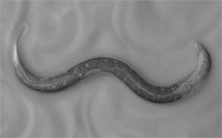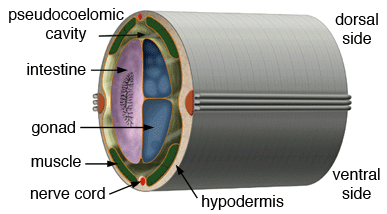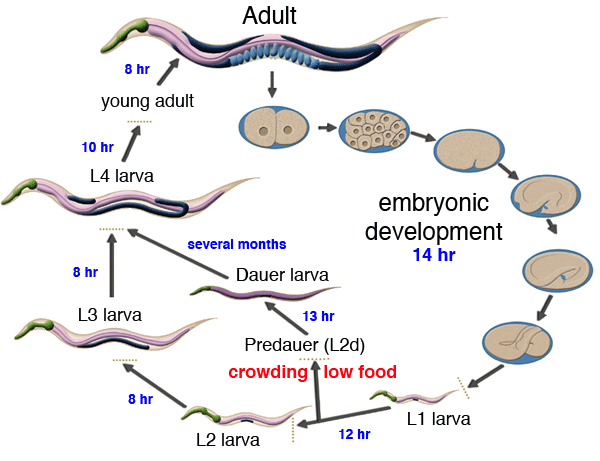What is C. elegans?
Caenorhabditis elegans, or C. elegans, is a small roundworm (nematode) usually found in the soil in temperate climates all around the world. It feeds on microorganisms like bacteria and can be most easily isolated from rotten fruit.

Figure 1: C. elegans moving on an agar plate
In the 1960s Sydney Brenner at the MRC laboratory in Cambridge, England, decided to use this particular species as a new model organism to study embryonic development. Specifically he was looking for a multicellular organism that was small, had a simple anatomy with only few cells, was easily cultivated and would reproduce quickly - hallmark features of many nematodes and C. elegans in particular. Since then C. elegans has become one of the most intensively studied animals and the number of researchers working with C. elegans today (2007) exceeds the number of cells this tiny animal has (959 in an adult hermaphrodite) ...
Anatomy
C. elegans has a simple anatomy with a small number of tissues and internal organs (see Figures 2 and 3). The head contains the brain and the prominent feeding organ - the pharynx. The main body is filled with the intestine and - in the case of an adult hermaphrodite - the gonad consisting of the uterus and spermatheka. Embryos start to develop inside the mother and are laid through the vulva around gastrulation stage.

Figure 3: C. elegans anatomy - cross section through the main body (artwork by Altun and Hall, © Wormatlas)
The body is cylindrical, surrounded by a sheet of epithelial cells (hypodermis) and protected by a secreted cuticle consisting of a variety of proteins (mainly collagens). Body wall muscle cells are arranged in four rows, two each on the ventral and dorsal sides (green in Figure 3). Major nerve cords run along the entire length of the body on the dorsal and ventral midline. The interior is a fluid-filled space (pseudocoelomic space) surrounding the intestine and gonad. C. elegans completely lacks skeletal elements and has no circulatory system. Adult animals are only 1mm in length about 0.2mm in diameter, small enough to allow oxygen from the air to diffuse through the body. Nutrients from the gut are simply released into the pseudocoelmic space and taken up by other cells. The animals are under internal hydrostatic pressure, which acts as 'hydrostatic skeleton'. Muscle cells are tightly connected to the external cuticle through the hypodermal cells. Contraction of muscle cells on one side leads to bending of the rigid body. Coordinated contractions allow movement in elegant sinusoidal waves (hence the name C. elegans). When worms dry out they loose their internal pressure and the ability to move (think of a ballon no longer able to maintain a rigid shape when loosing air). C. elegans critically depends on a moist environment and has little protection against desiccation.
Life cycle
C. elegans embryos develop rapidly and hatch after 14 hours. The first larval stage is completed after another 12 hours and the animals proceed through four molt cycles before becoming adults. Under crowded conditions or in the absence of food larvae can choose an alternative developmental pathway leading to the dauer larva, which does not feed but can survive adverse conditions for several months. When life gets better normal development is resumed, the animals exit the dauer larval stage and develop into the normal fourth larval stage before becoming adult. Adult animals are hermaphrodites and produce both sperm and eggs. Over the course of 3-4 days some 300 eggs are laid. The overall life span of C. elegans is 2-3 weeks. The short generation cycle facilitates genetic experiments and is a major advantage for researchers working with this organism.

